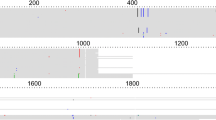Abstract
Phylogenetic analysis of nucleotide data from small subunit ribosomal DNA (SSU rDNA) sequences (ca. 1685 bp.) was performed on 19 taxa of the Onygenales and three related mitosporic fungi. Phylogenetic trees were constructed by the neighbor-joining method with the sequence data of related taxa obtained from DNA databases. The species in the Onygenales form two clusters and seven subclusters, and the tree topology reflects the traditional classification by Currah (1985) with some exceptions. The Myxotrichaceae is placed in the different lineage, separate from other plectomycetous taxa and among the Leotiales and the Erysiphales. Furthermore, two separate lineages in the Myxotrichaceae were found. Tree topology suggested the Onygenaceae is polyphyletic and composed of three subgroups; 1) most members of Onygenaceae, 2)Spiromastix warcupii, and 3) pathogenic dimorphic fungi classified inAjellomyces.
Similar content being viewed by others
Literature cited
Apinis, A. E. 1964. Revison of British Gymnoascaceae. Mycol. Pap. Commonw. Mycol. Inst.96: 1–56.
Arx, J. A. von 1987. A re-evaluation of the Eurotiales. Persoonia13: 273–300.
Benjamin, R. K. 1956. A new genus of the Gymnoascaceae with a review of the other genera. El Aliso3: 301–328.
Benny, G. L. and Kimbrough, J. W. 1980. A synopsis of the orders and families of plectomycetes with keys to genera. Mycotaxon12: 1–91.
Bowman, B. H. and Taylor, J. W. 1993. Molecular phylogeny of pathogenic and non-pathogenic Onygenales. In: The fungal holomorph: Mitotic, meiotic and pleomorphic speciation in fungal systematics, (ed. Reynolds, D. R. and Taylor, J. W.), pp. 169–178. CAB International, Wallingford.
Bowman, B. H., White, J. T. and Taylor, J. W. 1996. Human pathogenic fungi and their close nonpathogenic relatives. Mol. Phylogenet. Evol.6: 89–96.
Currah, R. S. 1985. Taxonomy of the Onygenales: Arthrodermataceae, Gymnoascaceae, Myxotrichaceae and Onygenaceae. Mycotaxon24: 1–216.
Currah, R. S. 1994. Peridial morphology and evolution in the prototunicate ascomycetes. In: Ascomycete systematics: Problems and perspectives in the nineties, (ed. Hawksworth, D. L.), pp. 281–293. Plenum Press, New York.
Currah, R. S. 1995. Ecological data and the systematics of the Onygenales: Proc. 3rd Intern. Symp. Mycol. Soc. Japan, Nov. 30–Dec. 1, 1995, pp. 68–72. Nat. Hist. Mus. Inst., Chiba, Japan.
Currah, R. S. and Locquin-Linard, M. 1988.Spiromastix grisea sp. nov. and its relationship to other Onygenaceae with helical appendages. Can. J. Bot.66: 1135–1137.
Dalpé, Y. 1989. Ericoid mycorrhizal fungi in the Myxotrichaceae and Gymnoascaceae. New Phytol.113: 523–527.
Felsenstein, J. 1985. Confidence limits on phylogenies: An approach using the bootstrap. Evolution39: 783–791.
Guarro, J., Gené, J. and de Vroey, C. H. 1993. A new species ofSpiromastix from Africa. Mycotaxon46: 307–313.
Hambleton, S., Currah, R. S. and Egger, K. N. 1998a. Phylogenetic relationships of ascomycetous root endophytes of the Ericaceae inferred from 18S rDNA sequence analysis. Programme and Abs. 2nd Intern. Conf. Mycorrhiza, July 5–10, 1998, pp. 78–79. Swed. Univ. Agri. Sci., Uppsala, Sweden.
Hambleton, S., Egger, K. N. and Currah, R. S. 1998b. The genusOidiodendron: species delimitation and phylogenetic relationships based on nuclear ribosomal DNA analysis. Mycologia90: 854–869.
Hawksworth, D. L., Kirk, P. M., Sutton, B. C. and Pegler, D. N. 1995. Ainsworth & Bisby's dictionary of the fungi, 8th ed. CAB International, Wallingford, U.K.
Kawasaki, M., Aoki, M., Ishizaki, H., Nishio, K., Mochizuki, T. and Watanabe, S. 1992. Phylogenetic relationships of the generaArthroderma andNannizzia inferred from mitochondrial DNA analysis. Mycopathologia118: 95–102.
Kimura, M. 1980. A simple method for estimation of evolutionary rate of base substitutions through comparative studies of nucleotide sequences. J. Mol. Evol.16: 111–120.
Kuehn, H. H. 1958. A preliminary survey of the Gymnoascaceae. I. Mycologia50: 417–439.
Kuehn, H. H. 1959. A preliminary survey of the Gymnoascaceae. II. Mycologia51: 665–692.
Landvik, S., Shailer, N. F. J. and Eriksson, O. E. 1996. SSU rDNA sequence support for a close relationship between the Elaphomycetales and the Eurotiales and Onygenales. Mycoscience37: 237–241.
LeClerc, M. C., Philippe, H. and Guèho, E. 1994. Phylogeny of dermatophytes and dimorphic fungi based on large subunit ribosomal RNA sequence comparisons. J. Med. Vet. Mycol.32: 331–341.
Pan, S., Sigler, L. and Cole, G. T. 1994. Evidence for a phylogenetic connection betweenCoccidioides immitis andUncinocarpus reesii (Onygenaceae). Microbiology140: 1481–1494.
Pearson, W. R. and Lipman, D. J. 1988. Improved tools for biological sequence comparison. Proc. Natl. Acad. Sci. USA85: 2444–2448.
Saitou, N. and Nei, M. 1987. The neighbor-joining method: A new method for reconstructing phylogenetic trees. Mol. Biol. Evol.4: 406–425.
Uchiyama, S., Kamiya, S. and Udagawa, S. 1995.Spiromastix saturnispora, a new species from Indonesian soil. Mycoscience36: 353–357.
Udagawa, S., Uchiyama, S. and Kamiya, S. 1993.Gymnostellatospora, a new genus of the Myxotrichaceae. Mycotaxon48: 197–205.
Udagawa, S. 1997. Taxonomic studies on Plectomycetes (Cleistothecial ascomycetes). Nippon Kingakukai Kaiho38: 143–157. (In Japanese.)
Weitzman, I., McGinnis, M. R., Padhye, A. A. and Ajello, L. 1986. The genusArthroderma and its later synonymNannizzia. Mycotaxon25: 505–518.
Yotsumoto, Y., Ohara, A. and Mikawa, T. 1995. A convenient method for extraction and purification of DNA from filamentous fungi. Microbiol. Cult. Coll.11: 19–21. (In Japanese.)
Author information
Authors and Affiliations
About this article
Cite this article
Sugiyama, M., Ohara, A. & Mikawa, T. Molecular phylogeny of onygenalean fungi based on small subunit ribosomal DNA (SSU rDNA) sequences. Mycoscience 40, 251–258 (1999). https://doi.org/10.1007/BF02463962
Accepted:
Issue Date:
DOI: https://doi.org/10.1007/BF02463962




